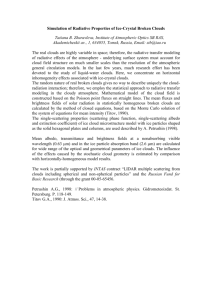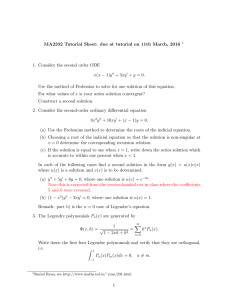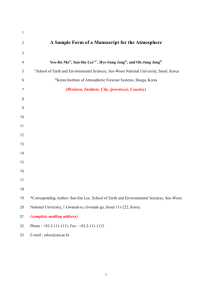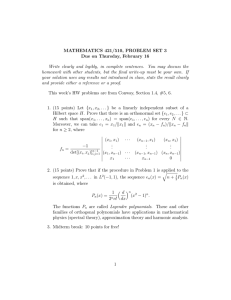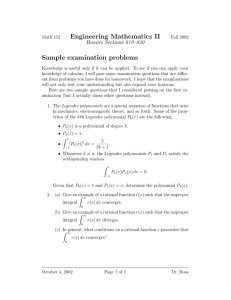Author's personal copy Journal of Quantitative Spectroscopy & Radiative Transfer
advertisement
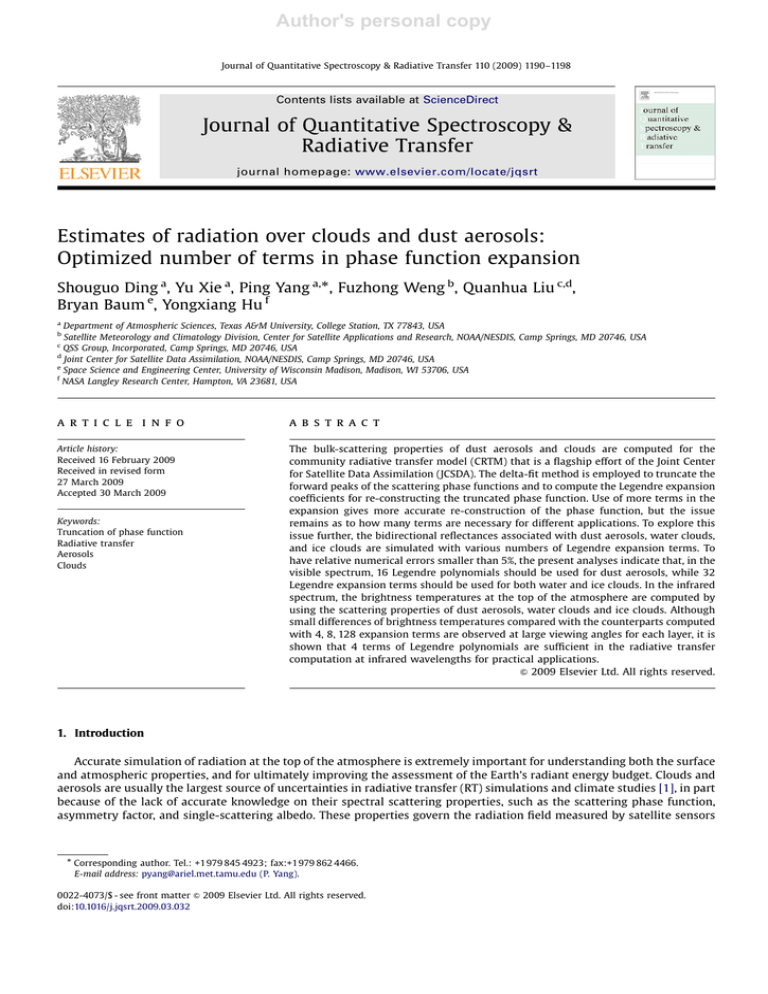
Author's personal copy ARTICLE IN PRESS Journal of Quantitative Spectroscopy & Radiative Transfer 110 (2009) 1190–1198 Contents lists available at ScienceDirect Journal of Quantitative Spectroscopy & Radiative Transfer journal homepage: www.elsevier.com/locate/jqsrt Estimates of radiation over clouds and dust aerosols: Optimized number of terms in phase function expansion Shouguo Ding a, Yu Xie a, Ping Yang a,, Fuzhong Weng b, Quanhua Liu c,d, Bryan Baum e, Yongxiang Hu f a Department of Atmospheric Sciences, Texas A&M University, College Station, TX 77843, USA Satellite Meteorology and Climatology Division, Center for Satellite Applications and Research, NOAA/NESDIS, Camp Springs, MD 20746, USA c QSS Group, Incorporated, Camp Springs, MD 20746, USA d Joint Center for Satellite Data Assimilation, NOAA/NESDIS, Camp Springs, MD 20746, USA e Space Science and Engineering Center, University of Wisconsin Madison, Madison, WI 53706, USA f NASA Langley Research Center, Hampton, VA 23681, USA b a r t i c l e i n f o abstract Article history: Received 16 February 2009 Received in revised form 27 March 2009 Accepted 30 March 2009 The bulk-scattering properties of dust aerosols and clouds are computed for the community radiative transfer model (CRTM) that is a flagship effort of the Joint Center for Satellite Data Assimilation (JCSDA). The delta-fit method is employed to truncate the forward peaks of the scattering phase functions and to compute the Legendre expansion coefficients for re-constructing the truncated phase function. Use of more terms in the expansion gives more accurate re-construction of the phase function, but the issue remains as to how many terms are necessary for different applications. To explore this issue further, the bidirectional reflectances associated with dust aerosols, water clouds, and ice clouds are simulated with various numbers of Legendre expansion terms. To have relative numerical errors smaller than 5%, the present analyses indicate that, in the visible spectrum, 16 Legendre polynomials should be used for dust aerosols, while 32 Legendre expansion terms should be used for both water and ice clouds. In the infrared spectrum, the brightness temperatures at the top of the atmosphere are computed by using the scattering properties of dust aerosols, water clouds and ice clouds. Although small differences of brightness temperatures compared with the counterparts computed with 4, 8, 128 expansion terms are observed at large viewing angles for each layer, it is shown that 4 terms of Legendre polynomials are sufficient in the radiative transfer computation at infrared wavelengths for practical applications. & 2009 Elsevier Ltd. All rights reserved. Keywords: Truncation of phase function Radiative transfer Aerosols Clouds 1. Introduction Accurate simulation of radiation at the top of the atmosphere is extremely important for understanding both the surface and atmospheric properties, and for ultimately improving the assessment of the Earth’s radiant energy budget. Clouds and aerosols are usually the largest source of uncertainties in radiative transfer (RT) simulations and climate studies [1], in part because of the lack of accurate knowledge on their spectral scattering properties, such as the scattering phase function, asymmetry factor, and single-scattering albedo. These properties govern the radiation field measured by satellite sensors Corresponding author. Tel.: +1 979 845 4923; fax:+1 979 862 4466. E-mail address: pyang@ariel.met.tamu.edu (P. Yang). 0022-4073/$ - see front matter & 2009 Elsevier Ltd. All rights reserved. doi:10.1016/j.jqsrt.2009.03.032 Author's personal copy ARTICLE IN PRESS S. Ding et al. / Journal of Quantitative Spectroscopy & Radiative Transfer 110 (2009) 1190–1198 1191 and therefore impact the retrieval of the microphysical and optical properties of clouds and aerosols. The quest for improving our understanding of the microphysical and optical properties of clouds and aerosols has led to substantial improvements in single-scattering computations, radiative transfer (RT) models, and remote sensing techniques. Recent advances have been made towards the calculation of the single-scattering properties for nonspherical aerosol and ice particles over a range of wavelengths from the ultraviolet (UV) to far infrared (far-IR) regimes. For example, scattering properties are now available for ice particles having relatively pristine shapes (e.g. hexagonal plates and columns) and more intricate particles, such as droxtals, 3D solid and hollow bullet rosettes, and aggregates. For flux calculations, the use of the asymmetry factor is usually sufficient. However, more detailed radiance simulations require use of the full scattering phase function, and often involve representing the scattering phase function in terms of a series of Legendre polynomials. In practice, how one decides on an appropriate set of Legendre polynomials for the phase function expansion is not always straightforward since the scattering phase functions can be quite complex. For example, the scattering phase function for large water droplets has some distinct features, such as the scattering peaks corresponding to primary and secondary rainbows. For the scattering of visible light by ice crystals having smooth surfaces, the phase function is dominated by a strong forward peak, sharp halo peaks, a scattering maximum at about Y ¼ 1561 where Y indicates the scattering angle, and a strong backscattering peak at Y ¼ 1801. Two well-known techniques have been developed to represent the scattering phase function in terms of Legendre polynomials in radiative transfer simulation: the d–M method by Wiscombe [2] and the d-fit method by Hu et al. [3]. The effect of the truncation of the phase function on radiative transfer simulation has been investigated by Iwabuchi and Suzuki [4]. Moreover, a thorough analysis of the phase function truncation has been performed by Nakajima and Tanaka [5]. If a scattering phase function has a strong forward peak, it may take literally thousands of Legendre polynomials to represent the original phase function. However, it may take less than 100 terms to replicate the phase function if one truncates the forward peak and subsequently renormalizes the phase function. This is important because for a RT model, such as the discrete ordinates radiative transfer (DISORT) [6], the computational time is proportional to the third power of the number of radiation streams. Note that, in DISORT, the number of the streams is the same as the number of Legendre polynomial expansion coefficients. In this paper, we apply the d-fit method to the RT simulations involving dust aerosols, water clouds, and ice clouds. To examine the trade-off between computational efficiency and numerical accuracy, we investigate the sensitivity of the RT calculations for dust aerosols, water clouds, and ice clouds at both visible and IR wavelengths to the number of Legendre polynomials in the phase function expansion. The intent of this effort is to optimize the efficiency of the RT simulations without sacrificing much accuracy. This work is pertinent because new single-scattering property databases for these types of particles are being incorporated into the community radiative transfer model (CRTM) [7] developed and maintained by the Joint Center for Satellite Data Assimilation (JCSDA). It is critical to efficiently represent the phase functions in the CRTM. Note that the radiative transfer solver in the CRTM is based on an advanced doubling-adding (ADA) method described in detail by Liu and Weng [8]. The ADA model employs an exact analytical expression for the source function, which substantially simplifies the conventional doubling-adding method. This paper is organized as follows. In Section 2, we present the numerical method for computing the bulk optical scattering properties of ice crystals, water droplets, and dust particles. In Section 3, we show the numerical results of the truncated phase functions that are re-constructed by using different terms of Legendre polynomials. In Section 4, we investigate the sensitivity of the bidirectional reflectances to the terms of the Legendre polynomial expansion of the truncated phase function. The final section summarizes and concludes our results. 2. Single-scattering properties of dust, water, and ice particles In this study, dust aerosol particles are assumed to be spheroids with an aspect ratio of 1.7. The bulk-scattering properties of dust aerosols are computed on the basis of a computational package developed by Dubovik et al. [9] who used a combination of the T-matrix method [10] and an improved geometric optics method (IGOM) [11] to compute a database of the optical properties of individual dust particles. The bulk scattering properties of dust aerosols are subsequently obtained by averaging the single-scattering properties over lognormal particle size distributions (PSDs) [12]. For water clouds, the single-scattering database is developed over the spectral range from 0.225 to 20.0 mm. Water clouds are assumed to consist solely of spherical liquid water droplets. The single-scattering properties of water droplets, including the asymmetry factor, single-scattering albedo, extinction efficiency, and scattering phase function, are computed from the Lorenz–Mie program developed by Wiscombe [13] for radii ranging from 0.1 to 200 mm. From the optical properties for individual droplets, the bulk scattering properties are developing by integrating over PSDs in the form [14] nðrÞ ¼ r ð13bÞ=b er=ab , (1) where r is the radius of the water cloud particle, a is the effective radii, and b is the effective variance. The single-scattering properties of individual ice crystals are based on those reported by Yang et al. [15,16]. To consider the distribution of ice crystal habit, we follow Baum et al. [17] who assumed the following percentages of various ice crystal habits: particles with Lo60 mm are 100% droxtals; particles with 60oLo1000 mm are 15% 3D bullet rosettes, 50% solid Author's personal copy ARTICLE IN PRESS 1192 S. Ding et al. / Journal of Quantitative Spectroscopy & Radiative Transfer 110 (2009) 1190–1198 columns, and 35% hexagonal plates; particles with 1000oLo2500 mm are 45% hollow columns, 45% solid columns, and 10% aggregates; and particles with L42500 mm are 97% 3D bullet rosette and 3% aggregates, where L is the maximum dimension of an ice particle. Furthermore, the bulk-scattering properties are derived by averaging the single-scattering properties over a set of 1117 particle size distributions obtained from five field campaigns, including the First International Satellite Cloud Climatology Project Regional Experiment (FIRE)-I, FIRE-II, Atmospheric Radiation Measurement Program (ARM), Tropical Rainfall Measuring Mission (TRMM), and the Cirrus Regional Study of Tropical Anvils and Cirrus Layers (CRYSTAL). Further details are provided in Baum et al. [17]. 3. Truncation of forward peak in the phase function The phase function can be expanded in terms of Legendre polynomials as follows: Pðcos YÞ ¼ N X ol Pl ðcos YÞ, (2) l¼0 where Y is the scattering angle, Pl ðcos YÞ are Legendre polynomials, ol are the expansion coefficients, and the value of the upper summation limit N depends on the desired numerical accuracy of the expansion. Thousands of terms may be required to accurately represent the phase function of an ice cloud in the visible spectrum, but the computational burden for the ensuing RT calculations makes this an unattractive approach. One way of reducing the necessary Legendre terms is by truncating the forward scattering peak and renormalizing the phase function. As an extension of the d–M method [2], the d-fit method [3] truncates the forward scattering peak in the phase function and more optimally fits the truncated phase function by selecting a set of optimized expansion coefficients in Eq. (2). Quantitatively, the truncation of the phase function can be expressed in terms of the following relation: PðyÞ 2f dðcos y 1Þ þ ð1 f ÞP 0 ðyÞ, (3) 0 where P is the original phase function, P is the truncated phase function, d is the Dirac-delta function, and f is the portion of the scattered energy in conjunction with the truncated peak in the function. Note that both P and P0 in Eq. (3) are normalized. In this study, we use the d-fit method developed by Hu et al. [3] to truncate the forward peak in the phase function. To achieve the same accuracy in multiple scattering calculations with the truncated phase functions as with the nontruncated phase functions, an adjustment must be made to the optical thickness and single-scattering albedo via the following relations [18]: t0 ¼ ð1 f oÞt, (4) ð1 f Þo , 1 fo (5) o0 ¼ where f indicates the portion of the scattered energy associated with the truncated forward peak. In Eqs. (4) and (5), t and o are the original optical thickness and single-scattering albedo, respectively, whereas t0 and o0 are the optical thickness and single-scattering albedo associated with the truncated phase function. Fig. 1 shows the original scattering phase functions ðPÞ and the term ð1 f ÞP0 in Eq. (3) for dust, water clouds, and ice clouds at two wavelengths: 0.65 (left column) and 12.0 mm (right column). The term ð1 f ÞP0 is computed by using 8, 32, or 128 Legendre polynomial expansion terms. Panels (a) and (b) show the comparison for dust, panels (c) and (d) show the comparison for water clouds, and panels (e) and (f) show the comparison for ice clouds. For the three scattering media (dust, water clouds, and ice clouds), the forward scattering peaks of the original phase functions at 0.65 mm are much stronger than the counterparts at 12.0 mm because the size parameters for the former wavelength are larger than those for the latter wavelength. Panels (a) and (b) in Fig. 1 show the original phase functions and the term ð1 f ÞP 0 for dust at wavelengths of 0.65 and 12 mm. Because the size parameters for dust particles are small, the phase functions reconstructed in terms of 32 and 128 terms of Legendre polynomials are essentially the same as the original ones. When 8 terms of Legendre polynomials are used for reconstructing the phase function, an excellent agreement between the original phase function and ð1 f ÞP 0 is also observed at the 12 mm wavelength although pronounced errors are noticed at 0.65 mm. Panels (c) and (d) of Fig. 1 compare the phase functions for water clouds. Fairly close agreement is obtained between the original phase function and ð1 f ÞP0 across all scattering angles with the use of 128 terms. However, the primary and secondary rainbows and the glory can be simulated only by using 32 or more terms of Legendre polynomials. Furthermore, if simulations are required for comparison with a backscattering lidar, 32 or more terms may be necessary to obtain sufficient accuracy in the glory region. For the phase functions at the IR wavelength of 12.0 mm, the values of the fitted phase functions with 32 or more terms of Legendre polynomials are almost the same as the original functions. Panels (e) and (f) in Fig. 1 show the comparison of the phase functions for randomly oriented ice particles at wavelengths of 0.65 and 12.0 mm. At l ¼ 0.65 mm, the 221 and 461 halos, which are typical for ice crystals having hexagonal particle geometry, are present in addition to the strong forward-scattering peak, a backward-scattering peak, and a minor maxima at about 1561. The features of the phase functions at both wavelengths can be re-captured in the truncated phase Author's personal copy ARTICLE IN PRESS S. Ding et al. / Journal of Quantitative Spectroscopy & Radiative Transfer 110 (2009) 1190–1198 1193 Fig. 1. Comparison of the scattering phase functions P with the term ð1 f ÞP 0 with 8, 32, and 128 terms of Legendre polynomials for dust, and water and ice clouds at wavelengths of 0.65 and 12.0 mm. function by using 128 terms of Legendre polynomials. At l ¼ 0.65 mm, 32 or more terms of Legendre polynomials are required to fit the 1561 maxima and the backward scattering peak of the original scattering phase functions. At l ¼ 12.0 mm, the phase functions are smooth because the halos and the weak backward scattering peak vanish due to strong absorption at this wavelength. However, since the size parameters at this wavelength are large, the forward scattering peak due to diffraction is still quite pronounced. 4. Simulations of the bidirectional reflectances and brightness temperatures over clouds and dust aerosols To investigate the impact of the number of Legendre polynomials in the phase function expansion for RT computations, the bidirectional reflectances associated with dust, water clouds, and ice clouds are computed from the DISORT model for a particular set of solar zenith, satellite viewing zenith, and relative azimuth angles. Fig. 2 shows the bidirectional reflectances of dust, water cloud, and ice cloud at 0.65 mm using 128 terms of Legendre polynomials. The bidirectional Author's personal copy ARTICLE IN PRESS 1194 S. Ding et al. / Journal of Quantitative Spectroscopy & Radiative Transfer 110 (2009) 1190–1198 Fig. 2. Simulated bidirectional reflectances obtained by using 128 terms of the Legendre polynomials at a wavelength of 0.65 mm for dust, a water cloud, and an ice cloud. The solar zenith angle is 601. The optical depth t ¼ 1 and Re ¼ 1 mm are assumed for dust; t ¼ 20 and Re ¼ 10 mm for the water cloud; and t ¼ 5 and De ¼ 100.0 mm for the ice cloud. The red arc in each panel represents a satellite-viewing zenith angle of 701. (For interpretation of the references to color in this figure, the reader is referred to the web version of this article.) reflectances are calculated for a fixed solar zenith angle (yo ¼ 601) over a broad range of possible viewing zenith and relative azimuth angles. The optical depth t ¼ 1 and Re ¼ 1 mm are used for dust; t ¼ 20 and Re ¼ 10 mm for water clouds; and t ¼ 5 and De ¼ 100.0 mm for ice clouds. A relative azimuth angle of 01 represents the principal plane. For dust, the largest reflectances emerge in the forward scattering direction, within 0–301 of relative azimuth angle (f–f0), and with a satellite viewing zenith angle larger than about 751. Moreover, reflectance minima appear in the viewing zenith angle range between y ¼ 01 and 301. For water clouds, Fig. 2 indicates that the largest reflectances emerge in the forward scattering directions, within 0–601 of relative azimuth angle (f–f0), and with satellite viewing zenith angles larger than about 451. However, there is also a reflectance enhancement in the backscattering directions at viewing zenith angles greater than 601. The pattern for ice clouds is a similar pattern to that for water clouds, but with a reflectance enhancement across the entire range of relative azimuth angles at viewing zenith angles greater than 601. Given the bidirectional reflectance patterns obtained in Fig. 2, we now investigate the relative errors incurred by using fewer Legendre polynomial expansion terms. Here we assume the results with 128 terms to be ‘truth’. The relative error, d, of the bidirectional reflectance is defined by d¼ jR128 RN j 100, R128 (6) where R128 and RN are the simulated bidirectional reflectances based on 128 and N terms of the phase function expansion, respectively. Shown in Fig. 3 are the results for the use of N ¼ 16 terms (left column for dust, water clouds, and ice clouds, Author's personal copy ARTICLE IN PRESS S. Ding et al. / Journal of Quantitative Spectroscopy & Radiative Transfer 110 (2009) 1190–1198 1195 Fig. 3. The relative errors of bidirectional reflectances obtained for the scattering phase functions re-constructed in terms of 16, and 32 Legendre polynomials at a wavelength of 0.65 mm for dust layer, a water cloud, and an ice cloud. The solar zenith angle is 601. The optical depth t ¼ 1 and Re ¼ 1 mm are assumed for the dust layer; t ¼ 20 and Re ¼ 10 mm for the water cloud; and t ¼ 5 and De ¼ 100.0 mm for the ice cloud. The red arc in each panel represents a satellite viewing zenith angle of 701. (For interpretation of the references to color in this figure, the reader is referred to the web version of this article.) respectively) and 32 terms (right column). For each panel in Fig. 3, the red arc represents the contour of a satellite viewing zenith angle of 701. From Fig. 3, the relative errors of the bidirectional reflectances decrease with an increase in the number of the expansion terms involved in the re-construction of the phase function. As shown, use of 16 terms seems to be sufficient for calculations involving dust with relative errors less than 5% at both the wavelengths. For water clouds, however, there are angular regions in both forward- and back-scattering regions with relative errors higher than 10%. As noted earlier, the primary and secondary rainbows in the phase functions can be obtained only by using 32 or more Legendre polynomial terms, and relative errors in the bidirectional reflectance obtained with use of 32 terms are generally less than 4% over most relative azimuth and viewing zenith angles. Since the phase function for an ice cloud is more complex than that of either a dust layer or a water cloud, the bidirectional reflectances for ice clouds are more sensitive to solar-satellite relative azimuth and satellite viewing zenith angles. Overall, the results shown in Fig. 3 indicate that the relative errors of the bidirectional reflectances decrease significantly with an increase in the number of Legendre polynomial terms. Fig. 4 shows the relative errors of bidirectional reflectances at 0.65 mm as a function of scattering angle as calculated from the scattering phase functions re-constructed with N ¼ 16 or 32 terms. In Fig. 4, the black circle symbols denote the relative errors for the viewing angles smaller than 701 and the red crosses indicate relative errors at the viewing angles larger than 701. When N ¼ 16 terms, the errors are under 5% for dust, but for water clouds, the relative errors are greater than 10% over a range of scattering angles from 1201 to 1501, particularly, when the viewing angles are larger than 701. With the solar zenith angle chosen, the corresponding scattering angles are smaller than 1551. Ice clouds provide the largest relative errors, sometimes exceeding 30%. However, for both water and ice clouds, use of 32 terms greatly decreases the relative errors, even when the viewing angles are larger than 701. Fig. 5 shows the brightness temperatures at the top of the atmosphere as a function of the viewing angle for l ¼ 12.0 mm, Ts ¼ 300 K, and Tc ¼ 255 K, where Ts and Tc are the temperatures of the surface and cloud/dust layer. Consistent with Fig. 1, the effective radii of the dust and water cloud are 1 and 10 mm, respectively, while the effective Author's personal copy ARTICLE IN PRESS 1196 S. Ding et al. / Journal of Quantitative Spectroscopy & Radiative Transfer 110 (2009) 1190–1198 Fig. 4. The relative errors of bidirectional reflectances obtained for scattering phase functions reconstructed with 16 and 32 Legendre polynomials at a wavelength of 0.65 mm for dust, water cloud and ice cloud. The solar zenith angle is 601. The optical depth t ¼ 1 and Re ¼ 1 mm are assumed for a dust layer; t ¼ 20 and Re ¼ 10 mm for the water cloud; and t ¼ 5 and De ¼ 100.0 mm for the ice cloud. The black circles denote the relative errors for viewing angles smaller than 701 and the red crosses represent relative errors at viewing angles larger than 701. (For interpretation of the references to color in this figure, the reader is referred to the web version of this article.) particle size for the ice cloud is 100 mm. For all three scattering media, the simulated brightness temperatures based on four terms of the phase function expansion are indistinguishable from the results obtained with 8 or 128 terms, even for viewing zenith angles as large as 801. Therefore, at infrared wavelengths, four terms of the Legendre polynomials are sufficient in RT simulations when small viewing zenith angles are used. 5. Summary and conclusions Three bulk-scattering property datasets are computed for dust aerosols, and water and ice clouds at wavelengths from 0.225 to 20.0 mm. The strong forward peaks of phase functions are truncated by the d-fit method and sets of Legendre polynomial expansion terms are formed. Based on the number of Legendre terms used to represent the scattering phase functions, relative errors for different scenarios are presented based on RT computations. As expected, use of more expansion terms tends to significantly improve the accuracy of the re-constructed phase function. However, fewer terms of the phase function expansion are required in the infrared regime than in the visible regime. It is also noted that truncated phase functions at visible wavelengths cannot match perfectly the original counterparts at some scattering angles, such as in the rainbow region for a water cloud and sharply peaked halos for an ice cloud. The sensitivity of bidirectional reflectances to the number of the phase function expansion terms is investigated. Error analyses of the reflectances for a water cloud show that the largest errors occur mainly at large scattering angles and in the rainbow region since the re-constructed phase functions may not match the original counterparts unless more Legendre terms are used. For ice clouds, the largest errors associated with the phase function expansion occur at scattering angles near 301 and 1501. It can be concluded from the error analyses that 32 terms of Legendre polynomials for the phase function expansion in the cases of water and ice clouds can be adopted to have relative errors smaller than 5% at all possible satellite zenith and azimuth angles at visible wavelengths, while only 16 Legendre polynomials are required for dust at the same wavelengths. Brightness temperatures are simulated for dust, and water and ice cloud layers at a wavelength of 12.0 mm. At this IR wavelength, four terms of the Legendre polynomial expansion terms are sufficient in the RT computations for the three particle types. Author's personal copy ARTICLE IN PRESS S. Ding et al. / Journal of Quantitative Spectroscopy & Radiative Transfer 110 (2009) 1190–1198 1197 Fig. 5. Simulated brightness temperatures over a dust layer (upper panel), a water cloud (middle panel), and an ice cloud (lower panel) at l ¼ 12.0 mm. The surface and cloud (dust layer) temperatures are assumed to be Ts ¼ 300 K and Tcloud or dust ¼ 255 K, respectively. The optical depths and effective particle sizes for the dust layer, water cloud, and ice cloud are indicated in each panel. Acknowledgments This study is supported by the Joint Center for Satellite Data Assimilation (JCSDA) under contract DG133E07SE3473/ NEED2000-7-15205. References [1] Solomon S, Qin D, Manning M, Chen Z, Marquis M, Averyt KB, et al., editors. IPCC, climate change 2007: the physical science basis. Contribution of working group I to the fourth assessment report of the intergovernmental panel on climate change. Cambridge, UK, New York, NY, USA: Cambridge University Press; 2007. [2] Wiscombe WJ. The delta-M method: rapid yet accurate radiative flux calculations for strongly asymmetric phase functions. J Atmos Sci 1977; 34:1408–22. [3] Hu YX, Wielicki B, Lin B, et al. d-Fit: a fast and accurate treatment of particle scattering phase functions with weighted singular-value decomposition least-squares fitting. JQSRT 2000;65:681–90. [4] Iwabuchi H, Suzuki T. Fast and accurate radiance calculations using truncation approximation for anisotropic scattering phase function. JQSRT 2009; doi:10.1016/jqsrt.2009.04.006. [5] Nakajima T, Tanaka M. Algorithms for radiative intensity calculations in moderately thick atmospheres using a truncation approximation. JQSRT 1988;40:51–9. [6] Stamnes K, Tsay SC, Wiscombe W, et al. A numerically stable algorithm for discrete-ordinate-method radiative transfer in multiple scattering and emitting layered media. Appl Opt 1988;27:2502–9. [7] Han Y, Van Delst P, Liu Q, et al. Community radiative transfer model (CRTM)—version 1. Technical Report 122, NOAA NESDIS; 2006. [8] Liu Q, Weng F. Advanced doubling-adding method for radiative transfer in planetary atmosphere. J Atmos Sci 2006;63:3459–65. Author's personal copy ARTICLE IN PRESS 1198 S. Ding et al. / Journal of Quantitative Spectroscopy & Radiative Transfer 110 (2009) 1190–1198 [9] Dubovik O, Sinyuk A, Lapyonok T, et al. The application of spheroid models to account for aerosol particle nonsphericity in remote sensing of desert dust. J Geophys Res 2006;111:D11208. [10] Mishchenko MI, Travis LD. Light scattering by polydispersions of randomly oriented spheroids with sizes comparable to wavelengths of observation. Appl Opt 1994;33:7206–25. [11] Yang P, Liou KN. Geometric-optics-integral-equation method for light scattering by nonspherical ice crystals. Appl Opt 1996;35:6568–84. [12] Kokhanovsky AA. Cloud optics. Dordrecht, Netherlands: Springer; 2006. [13] Wiscombe WJ. Improved Mie scattering algorithms. Appl Opt 1980;19:1505–9. [14] Hansen JE, Travis LD. Light scattering in planetary atmospheres. Space Sci Rev 1974;16:527–610. [15] Yang P, Liou KN, Wyser K, et al. Parameterization of the scattering and absorption properties of individual ice crystals. J Geophys Res 2000;105:4699–718. [16] Yang P, Wei HL, Huang HL, et al. Scattering and absorption property database for nonspherical ice particles in the near- through far-infrared spectral region. Appl Opt 2005;44:5512–23. [17] Baum BA, Heymsfield AJ, Yang P, et al. Bulk scattering properties for the remote sensing of ice clouds, I: microphysical data and models. J Appl Meteor 2005;12:1885–95. [18] Liou KN. An introduction to atmospheric radiation. 2nd ed. San Diego, CA: Academic Press; 2002.
